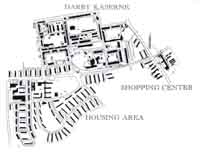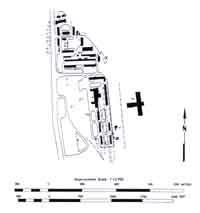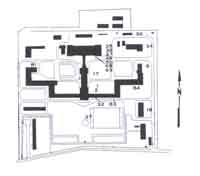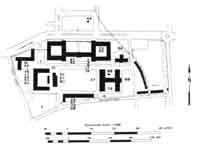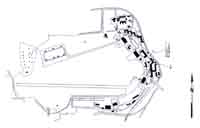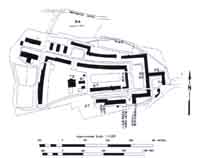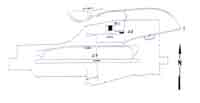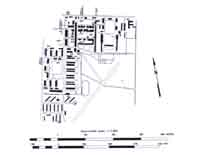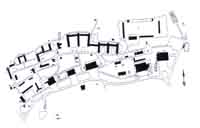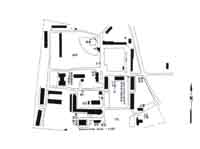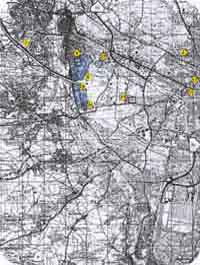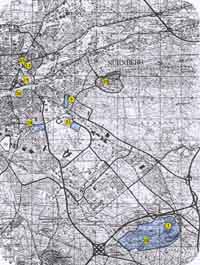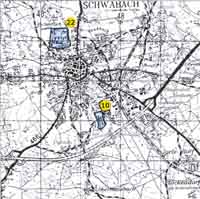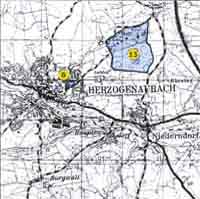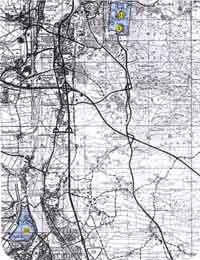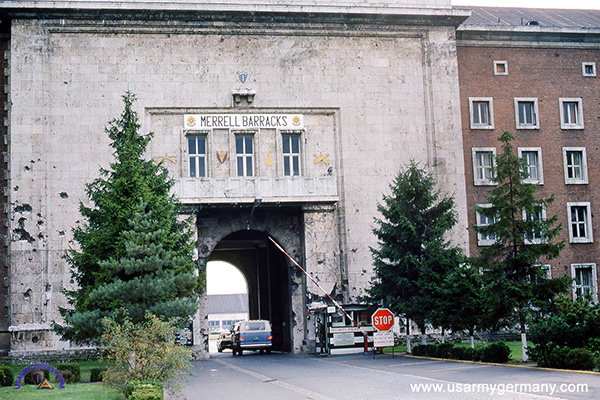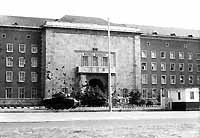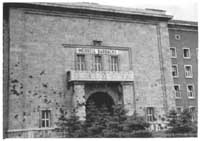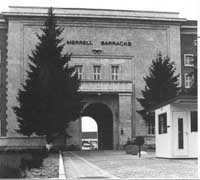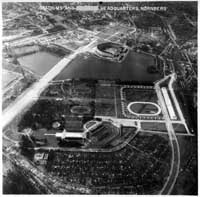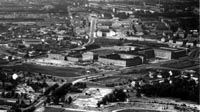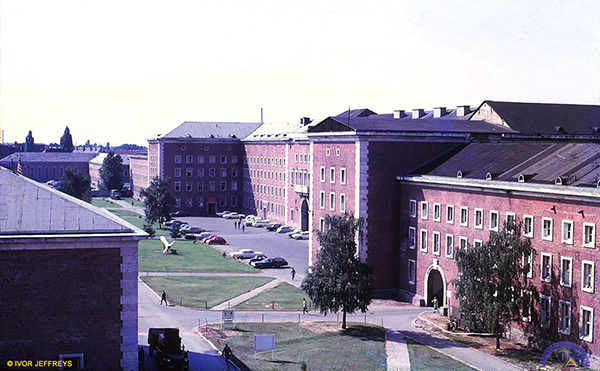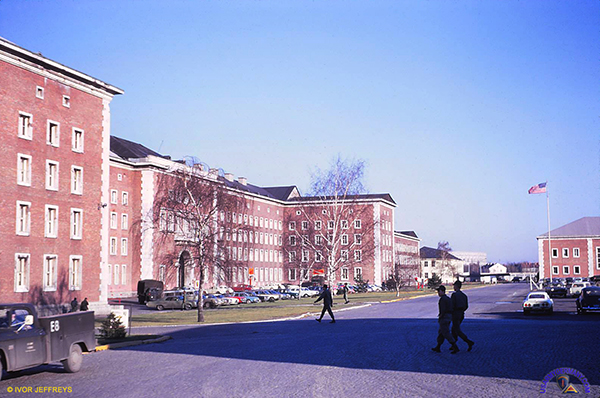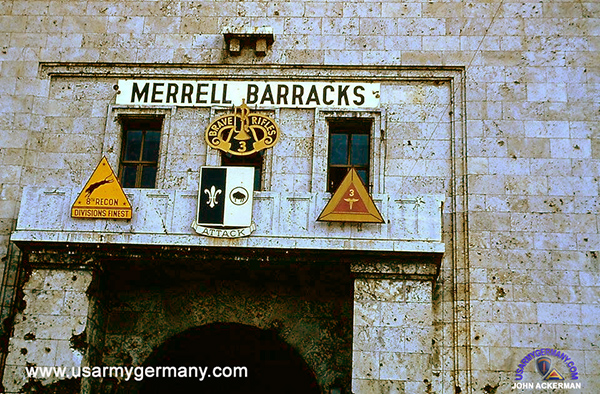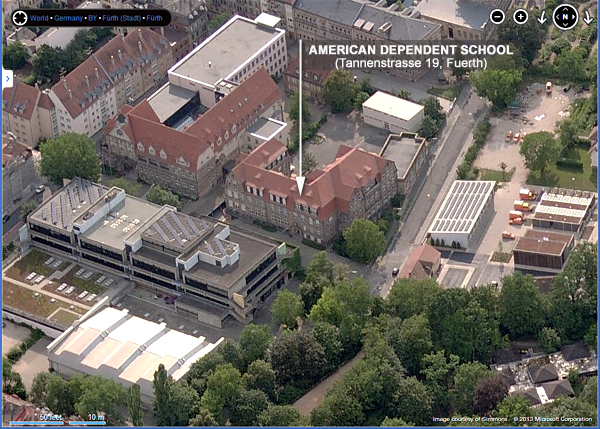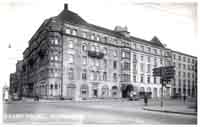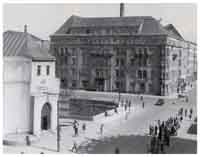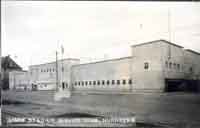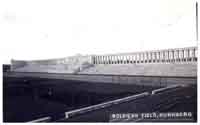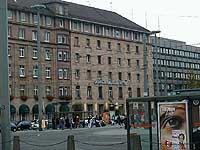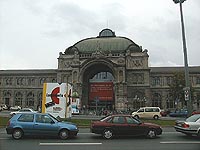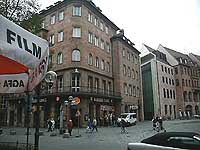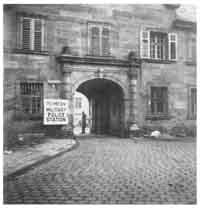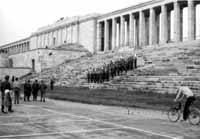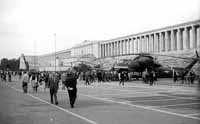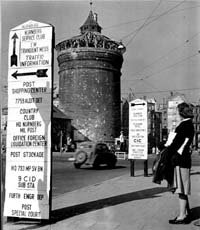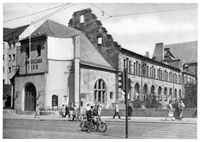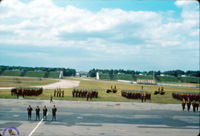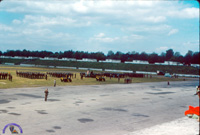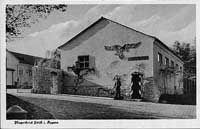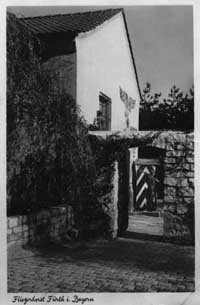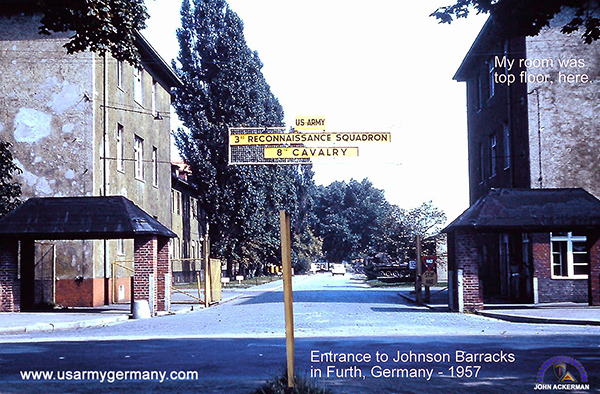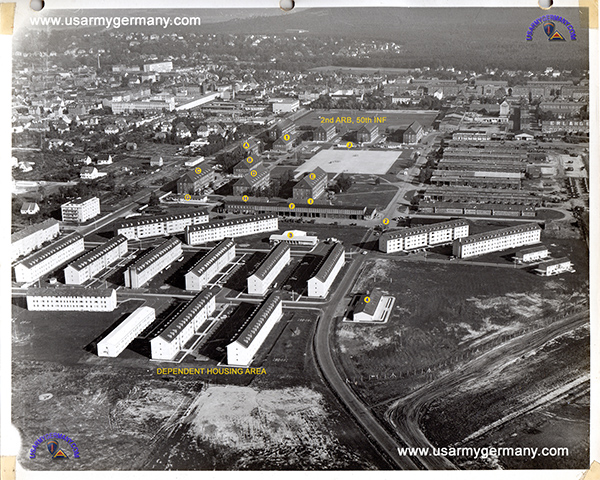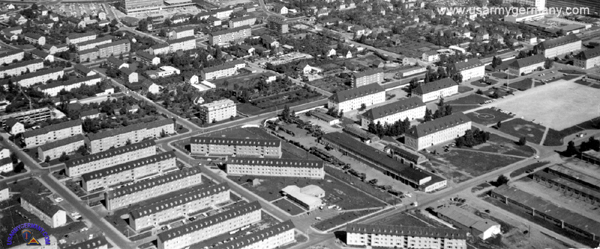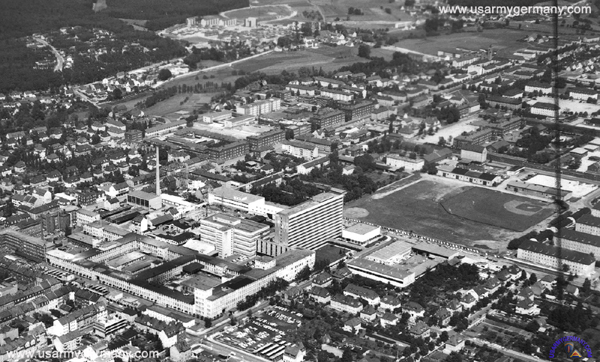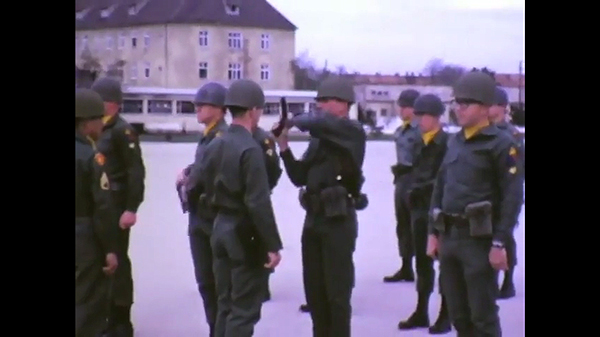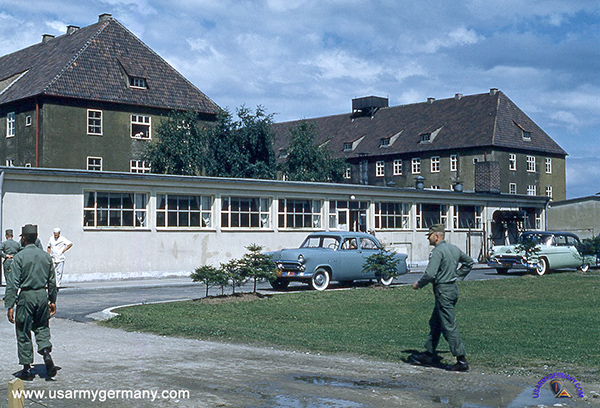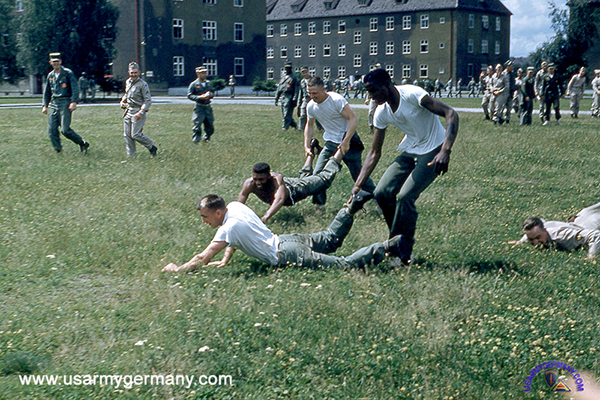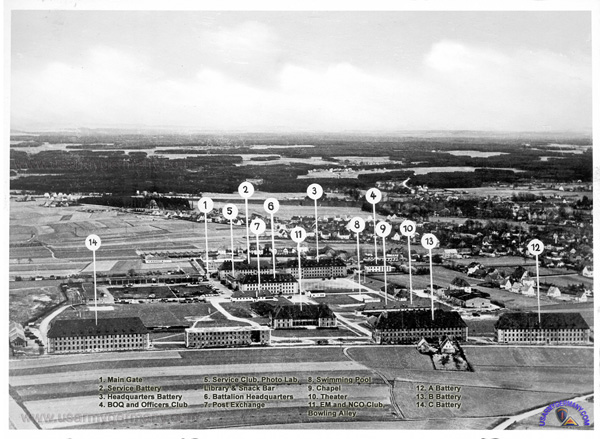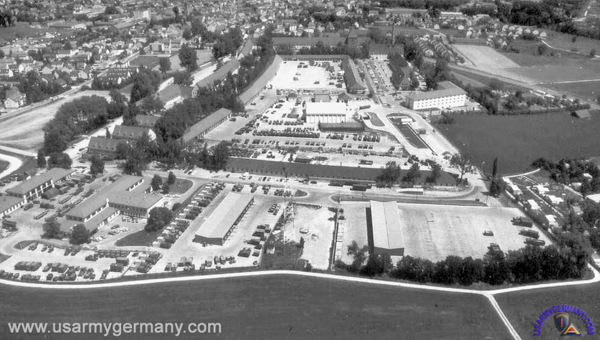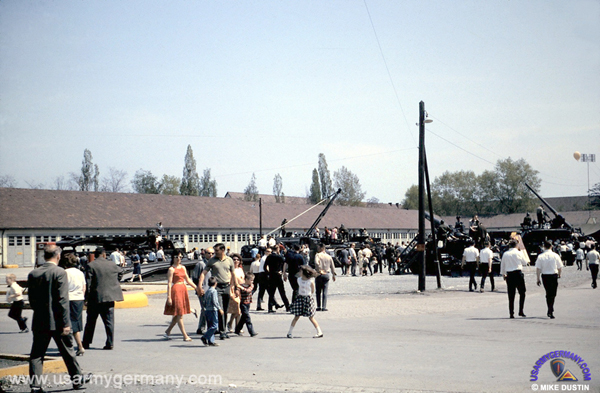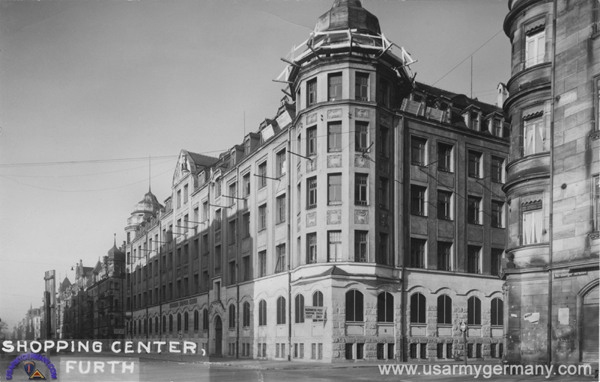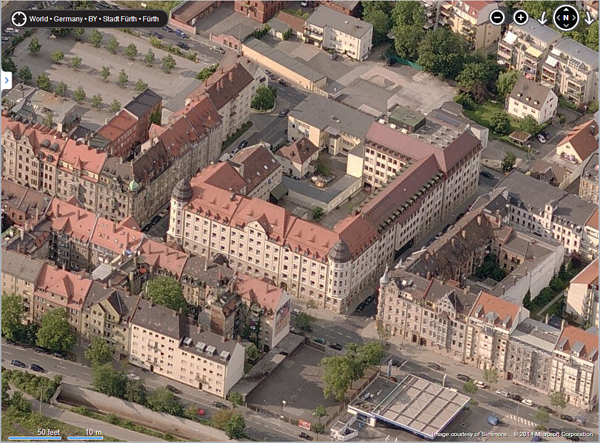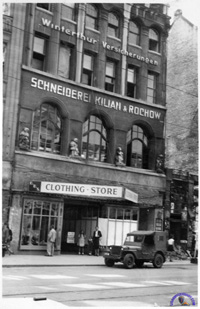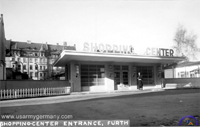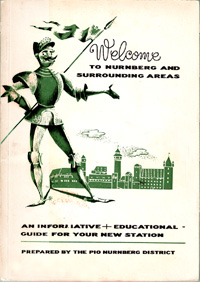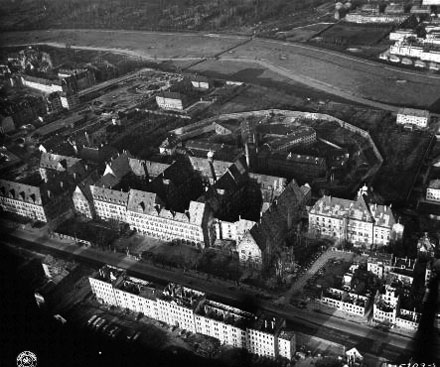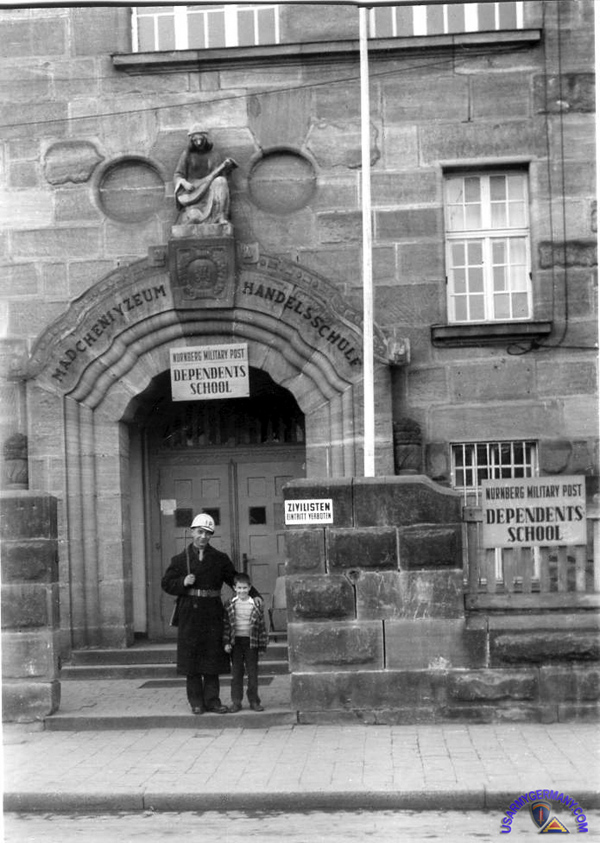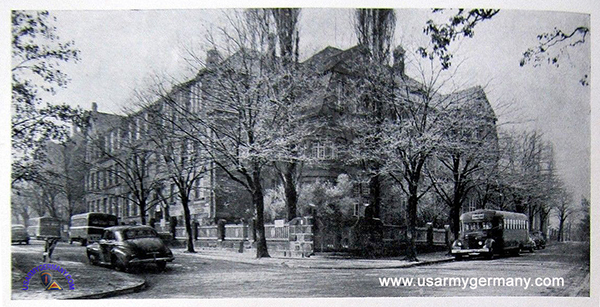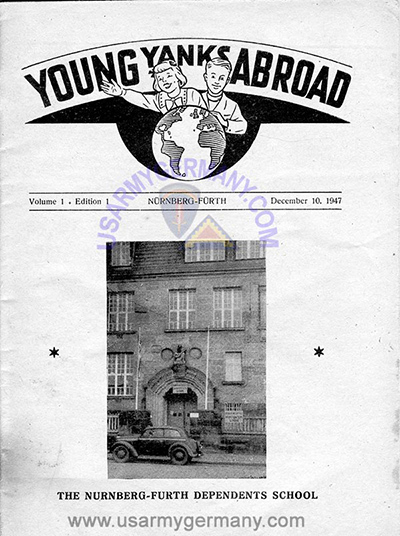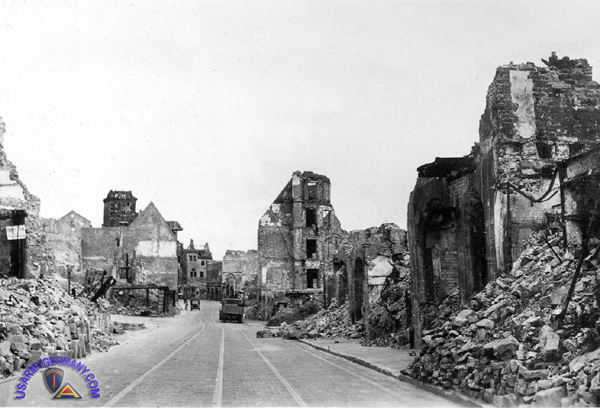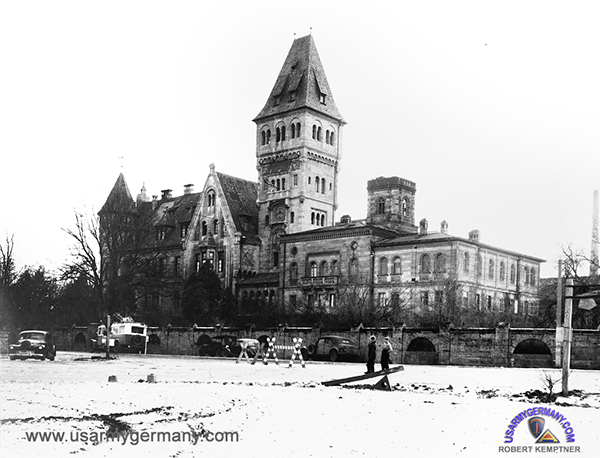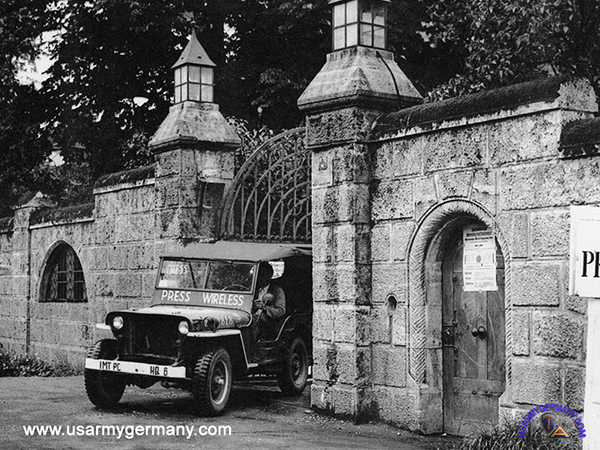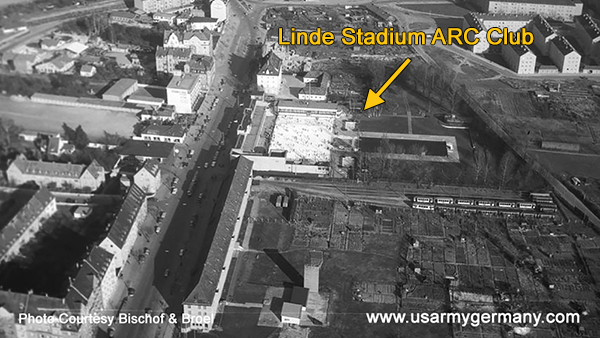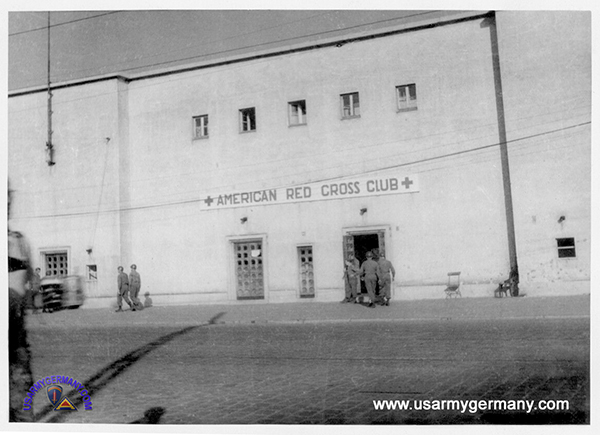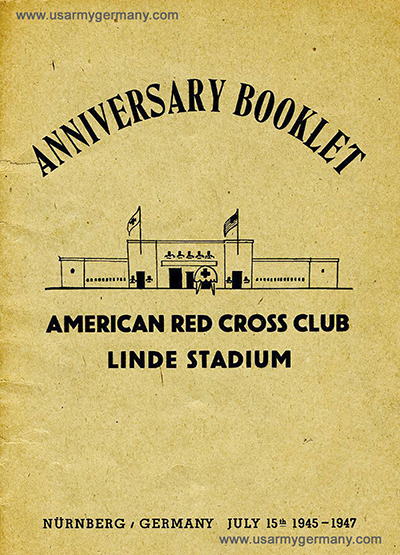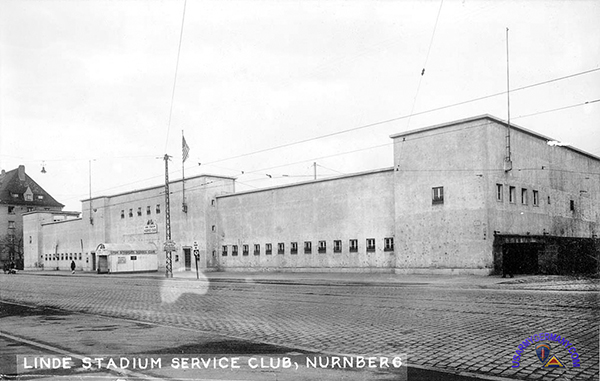Click here to open 'USArmyGermany' frameset
ADAMS BARRACKS |
HERZO BASE |
|
FEUCHT AAF |
||
FÜHRT MISC. |
| MAPS |
| 1980 Topographical maps of Nürnberg and surrounding area. These maps are reproduced from the "U.S. Military Installation Atlas" published by the 37th Transportation Group in 1980. Click on the thumbnail to view a larger format of the same map. Click here for a list of the installations. |
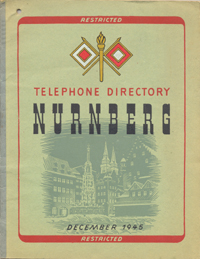 1. Nuernberg Telephone Directory, December 1945 |
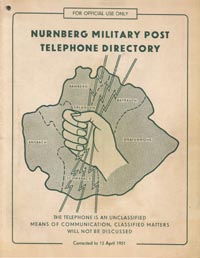 2. NMP Telephone Directory, 15 April 1951 |
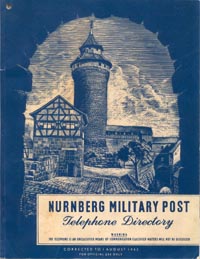 3. NMP Telephone Directory, 1 August 1952 |
|
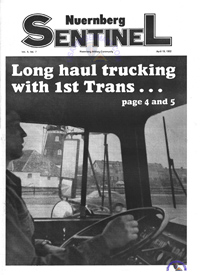 1. Nuernberg Sentinel - April 19 1982 |
|
|
|
|
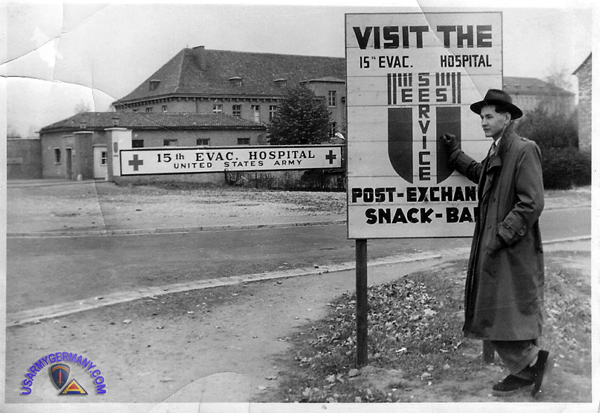 Army Hospital in Nuernberg, early days of the Occupation (Nuernberg MILCOM website) |
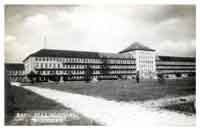 1. View of 385th Station Hosp, Nürnberg, 1947 |
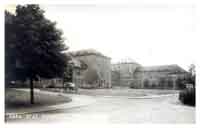 2. Another view of the 385th Sta Hosp, 1947 |
|||
|
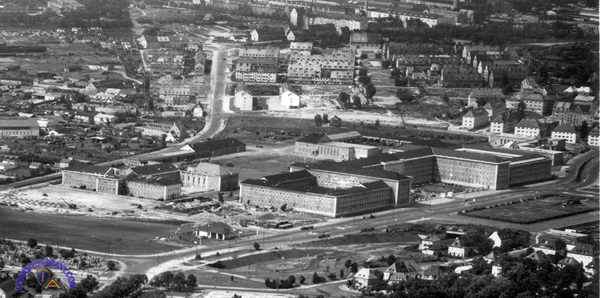 Aerial of Merrell Barracks, Nürnberg, early 1950s |
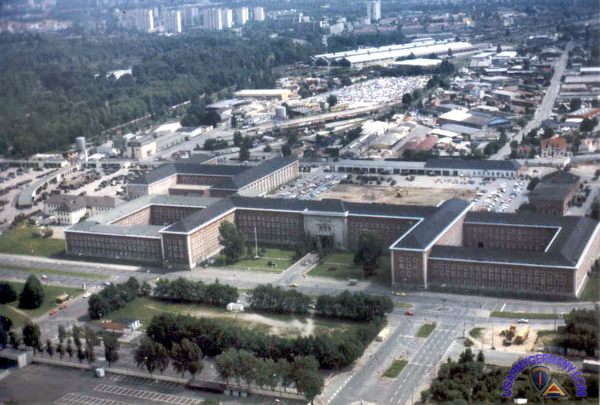 Aerial of Merrell Barracks, Nürnberg, 1980s |
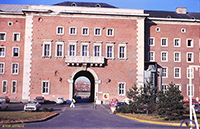 5. Entrance, around 1970 |
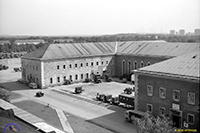 6. Bowling Alley, around 1970 |
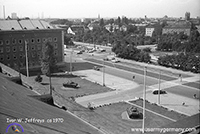 7. Access road, around 1970 |
||
|
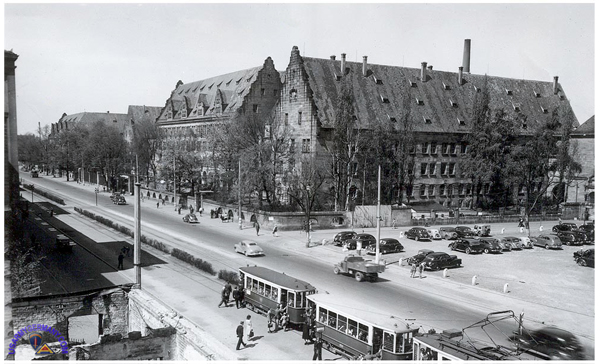 Palace of Justice, Nuerberg, 1947 |
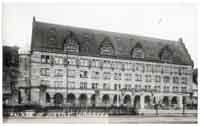 1. Palace of Justice, Nürnberg War Crimes Trials, 1947 |
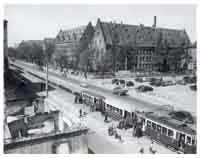 2. Palace of Justice, 1947 |
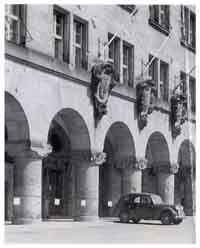 3. Palace of Justice, Main Entrance 1947 |
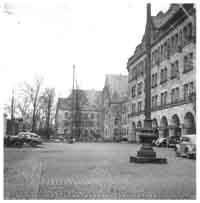 4. Palace of Justice, 1948 |
|
|
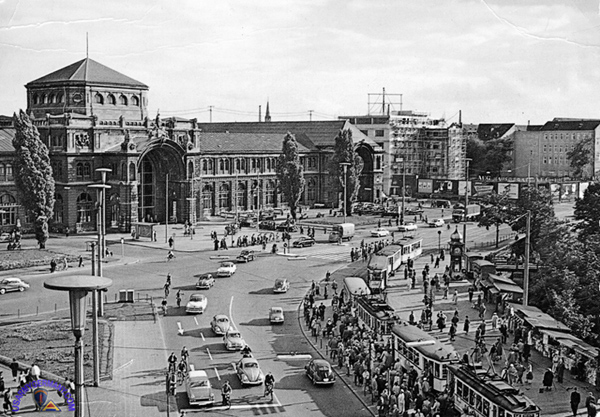 Nuernberg Hauptbahnhof, early 1960s (German postcard) |
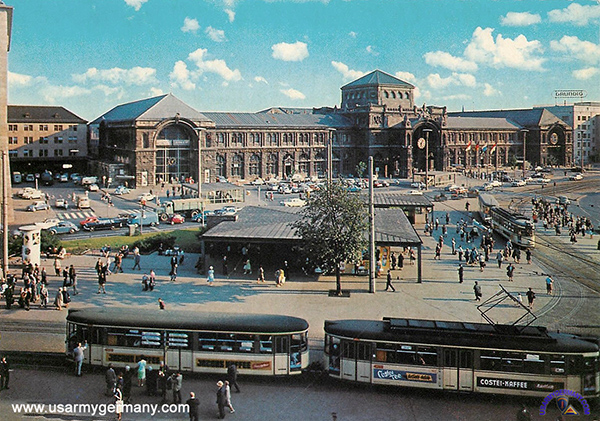 Nuernberg Hauptbahnhof, 1970s (German postcard) Where was the RTO located inside the train station? |
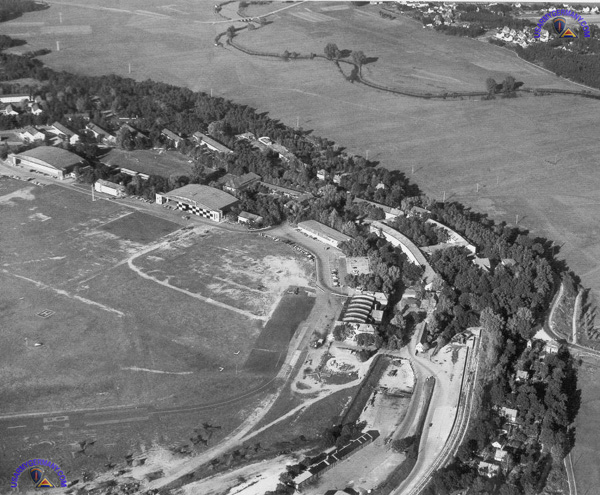 Monteith Barracks, early 1960s (Nuernberg MILCOM website) |
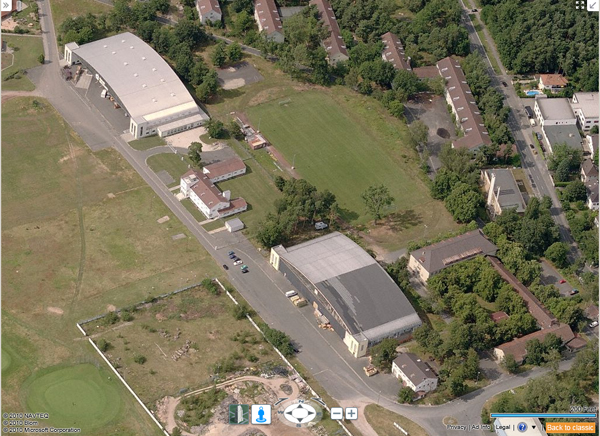 Bird's Eye View of Monteith Barracks (Bing) |
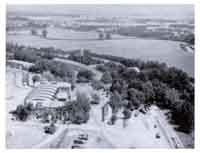 1. Aerial view of Monteith Bks, 1960 |
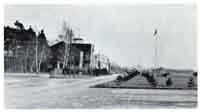 2. Monteith Bks, 1958 |
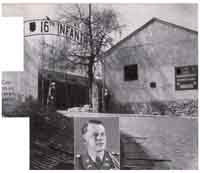 3. Main Gate of Monteith Bks in 1949/50 |
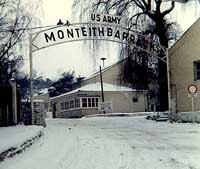 4. Main Gate, Monteith Bks, 1968 |
|
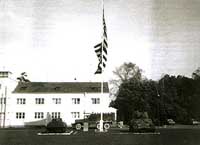 5. Flag pole, Monteith Bks, 1968 |
||||
|
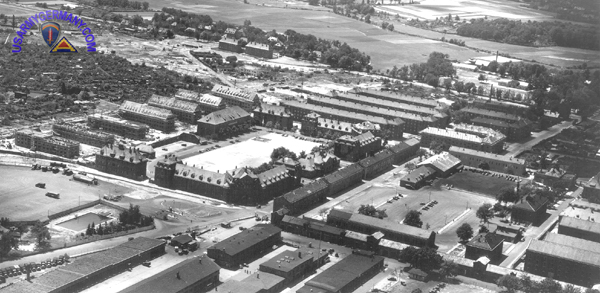 Darby Kaserne, 1950 |
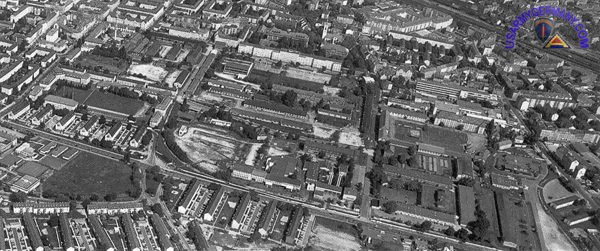 Darby Kaserne, 1990s |
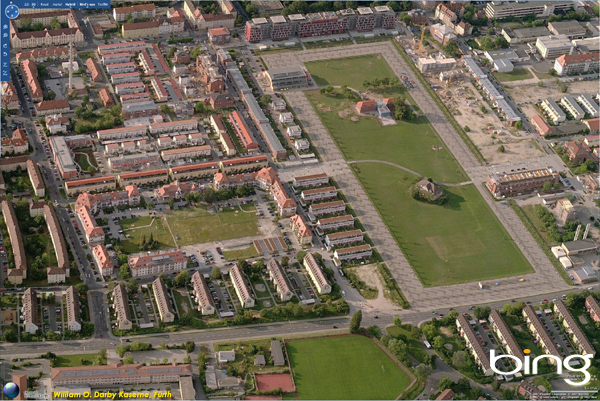 Bird's Eye view of former W.O. Darby Kaserne, (Bing) |
 6. Aerial view of W.O. Darby Ksn, 1950 Click here to supersize |
||||
|
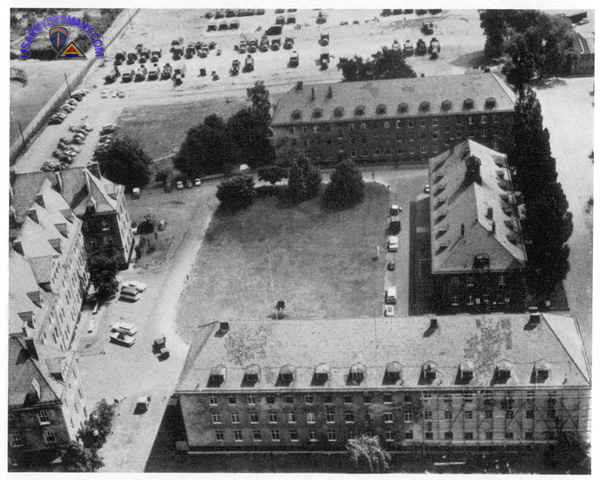 Johnson Barracks, Fuerth, 1960 |
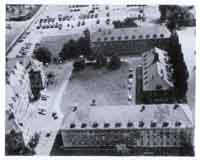 1. Aerial view of Johnson Bks, 1960 |
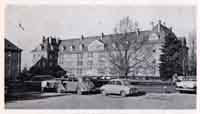 2. Johnson Bks, 1958 (150 KB) |
|||
|
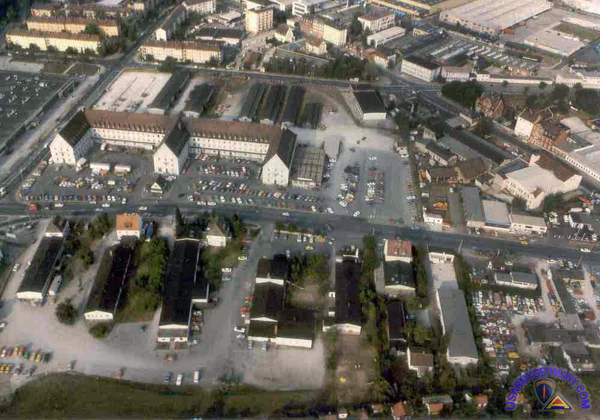 Former Medical Depot became the Fuerth Post Exchange |
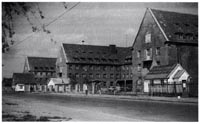 1. Fürth Medical Depot |
||||
|
||||
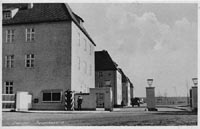 A. Panzer Ksn, Erlangen |
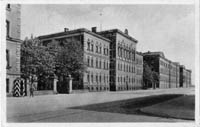 B. Infanterie Ksn, Erlangen |
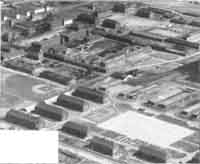 1. Aerial view of Ferris Bks in 1949/50 |
 2. Aerial view of Ferris Bks, 1950 Click here to supersize (588 KB) |
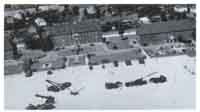 3. Aerial view of Ferris Bks, 1960 |
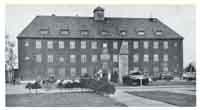 4. Ferris Bks, 1958 |
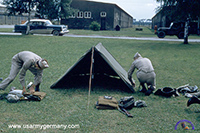 5. Ferris Bks, 1956 |
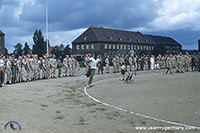 6. Ferris Bks, 1956 |
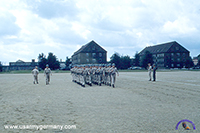 7. Ferris Bks, 1956 |
||
| Feucht | ||||
| Herzogenaurach | ||||
|
||||
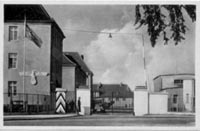 A. Nachrichten Kaserne |
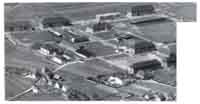 2. Aerial view of O'Brien Barracks in 1949/50 (112 KB) |
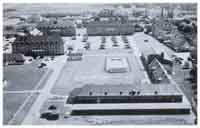 3. Aerial view of post in 1960 (142 KB) |
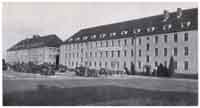 4. O'Brien Bks, 1958 (138 KB) |
 5. Main Gate of O'Brien Bks in 1949/50 (58 KB) |
|
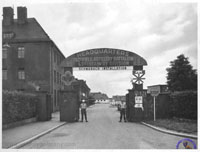 6. Main Gate, early 1950's (138 KB) |
||||
|
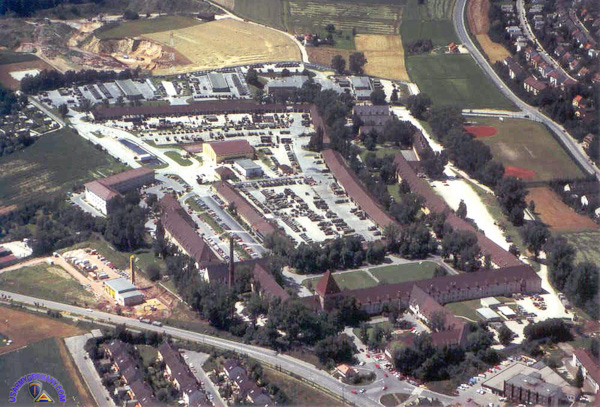 Pinder Barracks, Zirndorf (Nürnberg MILCOM website) |
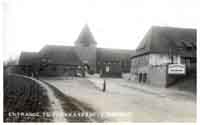 1. View of Main Gate, Flak Kaserne, 1947 |
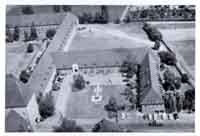 2. Aerial view of Pinder Bks, 1960 |
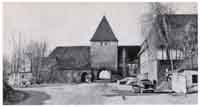 3. Main Gate of Pinder Bks, 1958 |
|
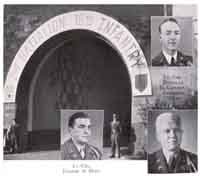 4. Main Gate, 1949/50 |
|
||
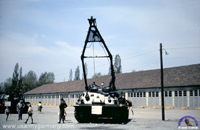 5. Open House, 1960s |
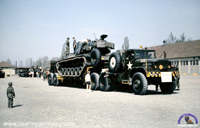 6. Open House, 1960s |
|
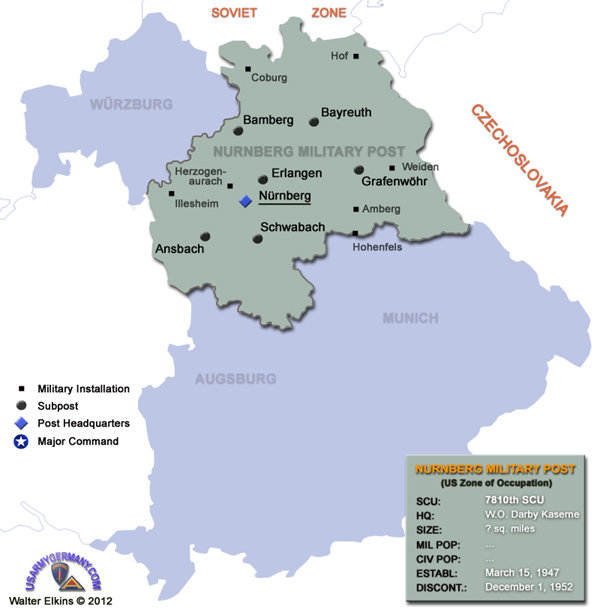 Map of Nürnberg Military Post (Walter Elkins) |
||||||||||||||||||||||||||||||||
| Nürnberg Military Post (March 1947 - December 1952) | ||||||||||||||||||||||||||||||||
| (Source: STARS & STRIPES, May 28 1950) | ||||||||||||||||||||||||||||||||
|
||||||||||||||||||||||||||||||||
|
||||||||||||||||||||||||||||||||
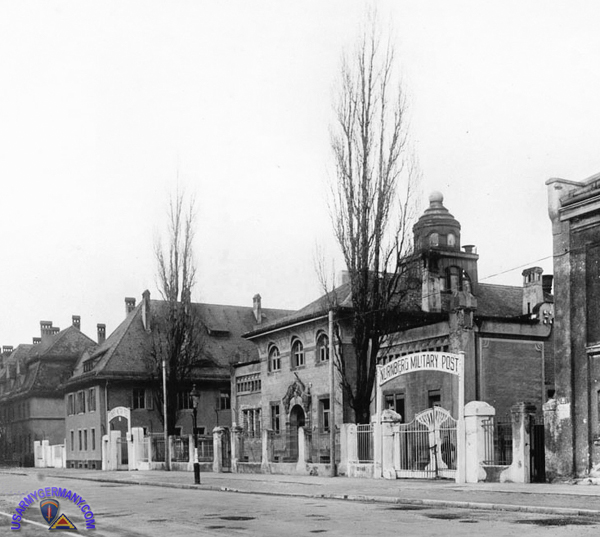 W.O. Darby Kaserne, Hqs Nürnberg Military Post. c. 1947 (Walter Elkins) |
||||||||||||||||||||||||||||||||
|
||||||||||||||||||||||||||||||||
|
||||||||||||||||||||||||||||||||
| Shopping Center - Nürnbergerstrasse, Fürth | ||||||||||||||||||||||||||||||||
| (Source: STARS & STRIPES, July 6, 1948) | ||||||||||||||||||||||||||||||||
| On July 2 1948, a new shopping center was officially opened by Col Frank S. Mansfield, CO of the Nurnberg Military Post, in a ceremony held in Fürth. Over 1,000 American military and dependents participated in the opening ceremony. The new shopping center, located at Nürnbergerstrasse 91-95 in Führt, contains a clothing store; commissary; snack bar; PX; gift shop; lounge; catalogue room; branch APO; American Express Co. and two insurance offices. Also located at the new center are a modern Stars and Stripes newsstand; a German post office and a branch Provost Marshal's office. Additional services will be added soon: barber, beauty and tailor shops; a portrait studio; watch and radio repair service; laundry and dry cleaning pickup; bottle goods and package good stores. The old Nürnberg clothing store (see photo below) has been closed and the former main PX installation at the Nurnberg Military Post has been reduced to service troops in the kaserne. (Webmaster note: the central shopping center on Nürnbergerstrasse would be replaced by a new and larger shopping center closer to W.O. Darby Kaserne in the 1950s. This new center was set up in the vacated Fürth Medical Depot facilities after that depot was moved to Einsiedlerhof near Kaiserslautern in 1951.) |
||||||||||||||||||||||||||||||||
|
||||||||||||||||||||||||||||||||
| (Source: Welcome to Nurnberg and Surrounding Areas, PIO Nuernberg District, prob 1950s) | ||||||||||||||||||||||||||||||||
|
Source: IRONSIDES, 1st Armored Division newspaper, May 6, 1988
| W. O. DARBY KASERNE, Fürth Artillerie Kaserne was constructed on Steubenstrasse in 1890. The kaserne, the former Sedan Kaserne which was located in the current Building 1 area, and the Train Kaserne which was located on Balbiererstrasse were confiscated by the US Army after WWII. Most of the 26th Inf Regt of the 1st Inf Div moved into the Darby complex on July 25, 1945. Along with providing security for the Nuernberg War Trials, the unit operated four hotels, two nightclubs, a bus line and 90 private homes for trial officials. On March 29 1949, the post was officially named for Brig. Gen. William O. Darby of the 10th Mountain Div, who was killed in action on April 30, 1945 at Tarbole, Italy. FERRIS BARRACKS, Erlangen Rheinland Kaserne, as Ferris was known during WWII, served as a training center for the German 25th Panzer Division. During the war, German anti-aircraft units were also stationed at the kaserne to protect Nuernberg from Allied bombing attacks. The kaserne was surrendered to the Americans on April 16, 1945. In 1948, Rheinland Kaserne was renamed Ferris Barracks in memory of 2nd Lt Jeffrey C. Ferris of the 2nd FA Bn, 1st Inf Div, who was killed during fighting in Tunisia. Tennenlohe Training Area near Ferris Bks has been a military training area since 1890. PINDER BARRACKS, Zirndorf Scheinwerferflak Kaserne was built in the late 1930s and housed a searchlight unit of the German Luftwaffe. After the war, the kaserne was occupied by the US Army. One of the earlier units occupying the kaserne was the 26th Infantry Regiment of the 1st Inf Div. In 1946, the 793rd MP Bn occupied the post. At this time, the battalion was involved in providing security at the Nuernberg War Trials. On May 11, 1949, the kaserne was renamed Pinder Barracks in honor of Tech 5th Grade John J. Pinder, who was post-humously awarded the Medal of Honor for his actions on June 6, 1944 near Colleville-sur-Mer, France. In May 1971, the 4th Armd DivArty, which had moved in during 1957, was redesignated as the 1st Armd DivArty. |
Source: Email from Jim Neville
I was a civilian employed at Herzo Base from approx Nov 1984 until July 28, 1990. I started as a Guidance Counselor at the Army Education Center, then located on the perimeter of the second floor of the old hangar building. The Education Specialist in charge of the Ed Center at that time was Bob Pinion, one of the best bosses I have ever had. |
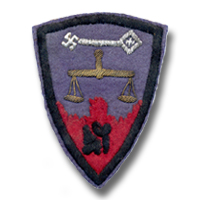 Nurnberg War Crimes Trial Patch |
|
|
||||
 1. (KB) |
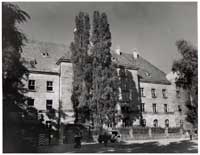 2. (KB) |
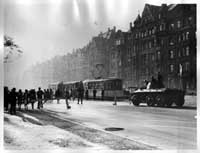 3. (KB) |
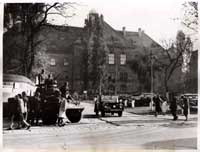 4. (KB) |
|
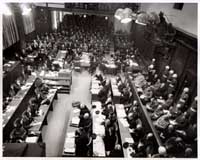 5. (KB) |
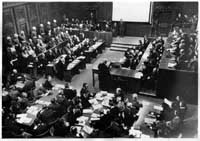 6. (KB) |
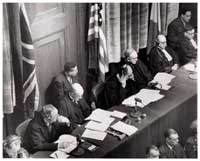 7. (KB) |
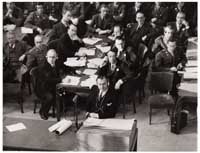 8. (KB) |
|
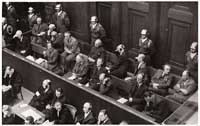 9. (KB) |
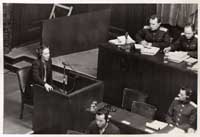 10. (KB) |
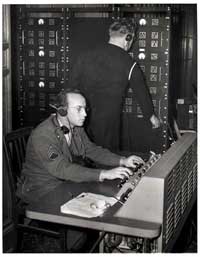 11. (KB) |
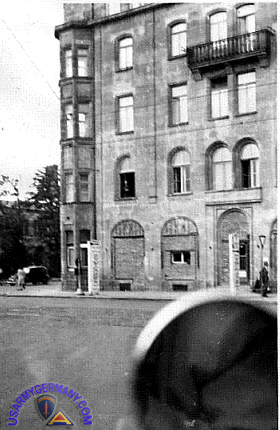 Grand Hotel during the Nuernberg Trials |
|
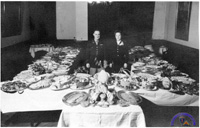 1. New Years Eve, 1946 |
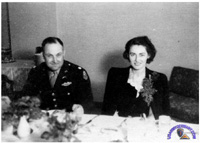 2. Col Patterson with Secretary |
| An Army dependent in bombed-out Nürnberg Here is my story. I was six years old when my mother and sister joined Col. Donald R. Patterson at Nurnberg on January 1947. He subsequently left managing the Grand Hotel (see above) but got a commendation from Telford Taylor about the food and accomodations. |
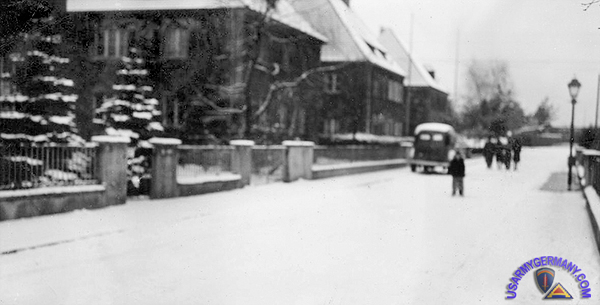
Villas on the Novalisstrasse (Nürnberg-Erlenstegen) requisitioned by the US Army
| We lived at 16 Novalistrasse where Hitler stayed during all of the ralleys. Nurnberg was Hitler's favorite city for the festivities. Willy Messerschmidt, the aircraft manufacturer, lived down the street on the last house on the street. I met his son and we became friends. |
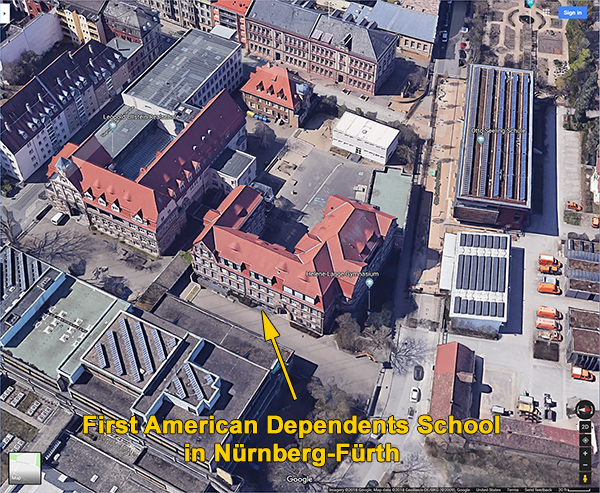
The American Dependents School on Tannenstrasse in Fürth
(GOOGLE Maps - 3D)
| Military dependents went to a school one hour's drive by bus. It was guarded by Polish guards who didn't like Nazi's. During the first grade nearby military fortifications were dynamited causing rattling windows and shaking desks. |
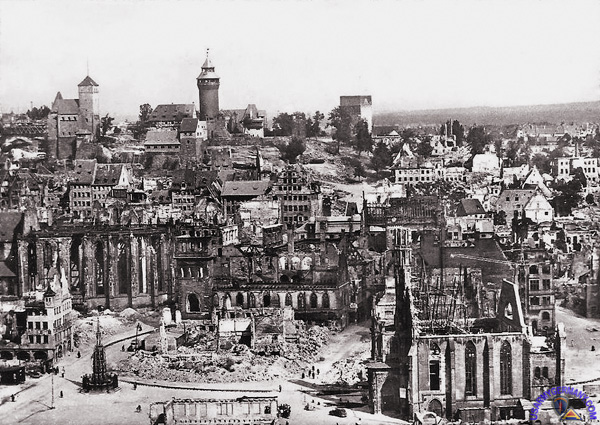
Over 90 percent of the city's center was destroyed by strategic bombing (German postcard)
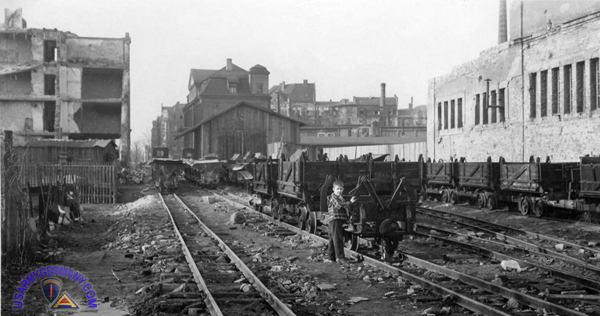
Donald explores empty hand carts used for rubble removal near damaged buildings
| The old wall city was nearly demolished as you can see from the photos. Fifteen years ago I visited the totally restored portion. Cleanup was on its way but not completed before the middle 60's. The people chipped off the mortar and loaded in hand carts with rails and dumped it beyond the city limits. The clean brick was then used for rebuilding. |
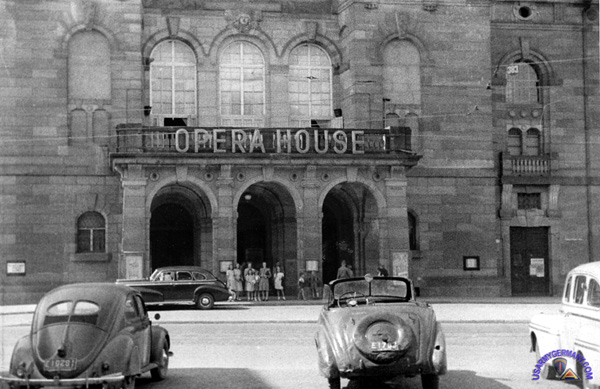
The Nürnberg Opera House
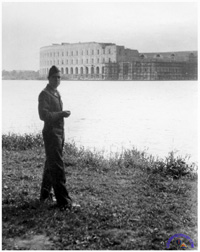 |
We saw movies at the Opera House and swam at the Olympic swimming pools. There was also a zoo that was functioning although some animals didn't survive the bombings. Upon our arrival there were many live bombs and 88 shells, one in our own backyard that had to be neutralized. We evacuated away from our house many times while demolition teams disarmed munitions. In the 1950's there were two unexploded 500 lb bombs found in the basement of the bombed portion of the Grand Hotel. The Bahnhof (train station) had a glass dome and while we were there the glass was gone. I saw it restored in the 1970's with glass and lighted at night. Photo (left): Colonel Robert Sherrard, my uncle, stands in front of the Colliseum where Hitler intended to imprison Churchill, Roosevelt and Stalin if he won the war. It was never completed before war's end. |
| Ardent Nazi's spit on us whenever we were around but a six year old could spit just as well as they did. Others who were denazified were very friendly and hungry.
There wasn't a day that didn't go by when childred would come to our door and said "Brot bitte." Or when you were through eating, you took apple cores and offered it to them or threw it away. They would fight over leftovers and go through our trash cans. Sanitation was another problem. You would see some Germans deficate at a storm drain while holding a newspaper in front. Our maids took my father's tobacco and roll their own cigarettes whenever he was finished. We gave them cigarettes and coffee. On the black market you could get anything with a can of coffee or a carton of cigarettes. I know because I stole a couple of cartons from my father to buy some electric trains. |
|
|
|||
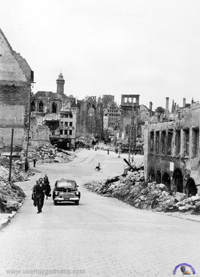 1. Marktplatz |
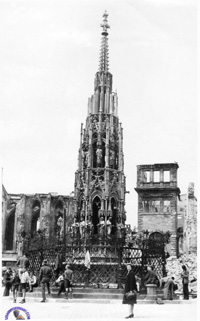 2. Schöner Brunnen |
In the early 1900's, a second castle, known as the "New Castle," was added. It consisted of a conservatory, a chapel and cloister, grouped around a rectangular courtyard. The original bell tower linked the two castles.
In 1939, the castle was confiscated by the German Wehrmacht.
In 1945, the US Army confiscated the castle and set up the Press Camp for journalists covering the International Military Tribunal in Nuernberg. Up to one hundred journalists from all over the world lived at the Press Camp during the first war crimes trial (1945-1946). The male trial observers stayed in the castle of the Faber-Castell family. Among the most famous new residents were exiled Germans such as Alfred Döblin, Willy Brandt, Erich Kästner and Markus Wolf. John dos Passos and the later US star reporter, Walter Cronkite, were also guests in Stein, as well as some Soviet reporters, e.g. Boris Polewoi or the cartoonist Nikolai Shukow. The Soviet journalists stayed in the former casino of officials, a building next to the castle, which the Americans called the "Russian Palace."
The castle was also used to house journalists during the subsequent war crimes trials held in Nuernberg between 1946 and 1949.
After the trials, the castle was used by the US Army as an officers and civilians club for the Nurnberg Military Post until 1953 when the property was turned over to the city of Nuernberg.
Another Army activity was temporarily housed at the castle - the Nuernberg Studio of AFN-Europe - before it was relocated to its permanent home at the Grand Hotel in Nuernberg in January 1950.
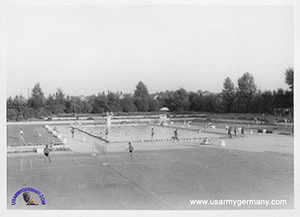 Swimming pool |
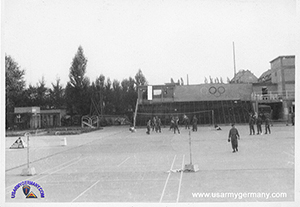 The patio with Volleyball and Badminton courts |
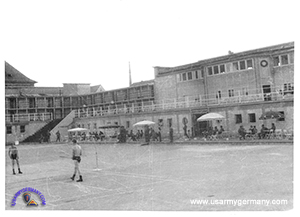 Outdoor tables and entrance to club lobby |
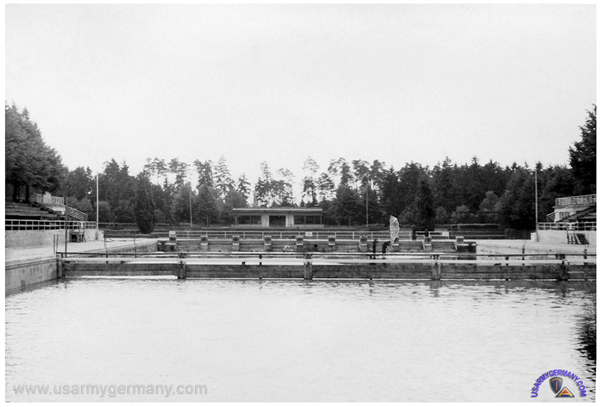
The swimming pool next to Linde Stadium used by American soldiers and their families
Confiscated by the US Army in 1945, the facility - comprised of an ice rink, outdoor swimming pool and (later) a snack bar, was initally operated by the American Red Cross. In 1947, the facility was turned over to Special Services of the Nurnberg Military Post and used as a recreation center.
The "Ice Parades of 1945" is believed to be the first ice show prepared for presentation before US soldiers in the European Theater. The show opened on November 11, 1945 at the Linde Stadium Red Cross Club. The event featured 30 American and German stars, some of international fame. Solo dance, barrel jump and pair skating routines were accompanied by the 764th Air Force Band. The show also marked the opening of the rink for soldier skaters.
Over the years, the facility hosted many hockey games, swimming meets as well as outdoor boxing matches for the US forces.
In February 1952, the stadium was returned to the City of Nuernberg. The turnover agreement stipulated that the facility would be available for joint use, allowing for a minmum of two special Amy swimming meets per year as well as ice hockey practice and games. In addition, the German authorities agreed to to maintian US Army health standards for the swimming pool.
| Zentrale
des Bundesamtes für die Anerkennung ausländischer Flüchtlinge. Nürnberg Military Community. A very interesting website that is an outgrowth of the book "Sternenbanner und Kleeblatt" (The Star-spangled Banner and the Cloverleaf), by Fuerth-native Bernd Jesussek. This book chronicles in detail the 50-year history of the U.S. Army in Fuerth. Great photos! Also, check out the Nürnberg MILCOM history page and the aerial photos of several of the kasernes. Ferris Barracks, Erlangen - an MSN Group for former or present soldiers who were once stationed at Ferris Barracks, Erlangen, FRG. Check out the Pictures link for some good photos of the post. A Farewell to Arms: The Nuremberg U.S. Military Community 1945 to 1995 - very nice site with a good history of the US Army presence in the Nürnberg area from the end of WWII to the closure of the military community. Garrison Museum Nürnberg - a German (sorry, only auf Deutsch) web page hosted by the Förderverein Garnisonmuseum Nürnberg with the purpose of presenting the history of Nürnberg as a garrison city over the past 1000 years. Experiences of Americans in Zirndorf - Official town of Zirndorf Homepage Nurnberg War Crimes Trials - a website hosted by the Bavarian Higher Reginal Court of Nürnberg, Germany Pinder Barracks - Yahoo Group; interesting messages - if you join the group you can access their photo section |
